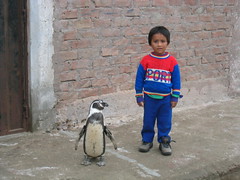Dunkin' Mau-nuts
This is Mau after the first dunking, she was a good sport even though she crushed her finger when she was hauled back into the raft. A bit further down we both got dumped into the river when the raft nearly flipped in some gnarly rapids.
When we got back to Baños, you guessed it, more caipiriñas! That cane liquor is a great antiseptic.













